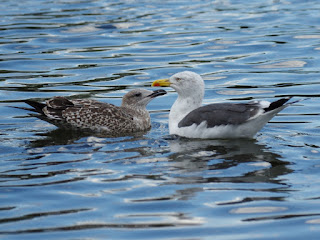A Polish migrant has returned. This Black-Headed Gull, ringed as a juvenile in Kampinos National Park near Gdansk on 14 June 2012, was first seen in Hyde Park on 6 November in the same year, only a few yards from where I found it today. It has visited the park every year since then.
The pigeon-eating Lesser Black-Backed Gulls have also returned from a much shorter excursion to the Round Pond. They were on the Serpentine, and the teenager was still pestering its father with plaintive mewing cries. And he was still taking no notice.
Two of the young Great Crested Grebes from the island were practising fishing together.
They didn't catch anything, and started preening. This one found that a feather came loose, and ate it. Grebes have to eat feathers constantly, either their own or ones they find in the water, to wrap up fishbones that might otherwise injure their intestines.
The pair of Egyptian Geese on the Vista, who have been there for more than ten years and never successfully raised a brood, seem to be getting together again.
The pair of Egyptians on the Round Pond who had two broods earlier this year are also showing signs of nesting. Their natural range extends from Egypt across the Equator to South Africa, and they have no notion of the passage of the seasons.
The rowan trees on Buck Hill had attracted some Parakeets, which were chewing berries in their messy way.
The usual Mistle Thrushes also flew in for a meal.
The Jackdaws behind the Albert Memorial came over for some peanuts. This one is waiting rather irritably on a branch for some Carrion Crows to fly away so that I can put a nut on the ground for it without them grabbing it first.
The male Little Owl was on his favourite branch in last year's nest tree.
His mate was in this year's nest tree, but fled into cover as soon as we looked at her.









Nice Grebe factlet there - I had no idea that they ate feathers with such enthusiasm, and for good reason too!
ReplyDeleteI think Pelicans do this too.
Delete